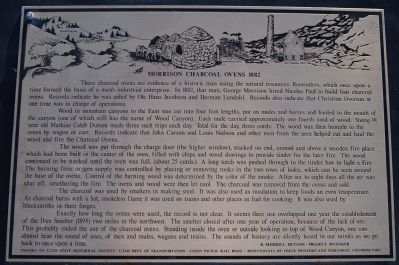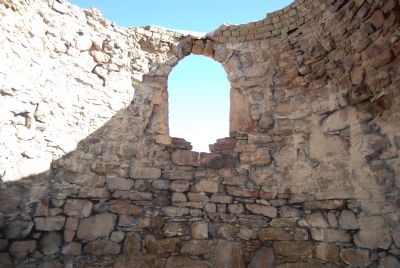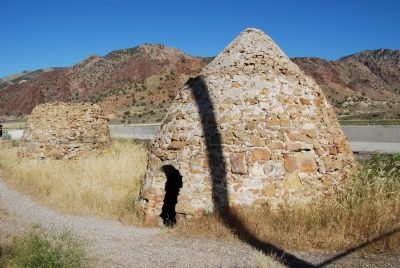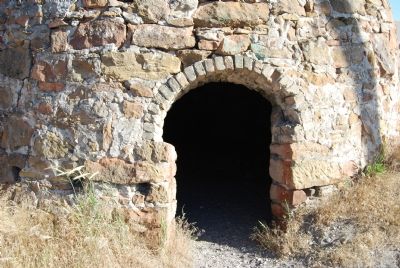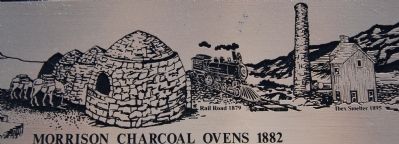Near Leamington in Millard County, Utah — The American Mountains (Southwest)
Morrison Charcoal Ovens 1882
Wood in mountain canyons to the East was cut into four foot logs, put on mules and horses and hauled to the mouth of the canyon (one of which still has the name of Wood Canyon). Each mule carried approximately one-fourth cord of wood. Young 18 year old Mathias Caeb Dutson made three such trips each day. Total for the day, three cords. The wood was then brought to the ovens by wagon or cart. Records indicate that John Carson and Louis Nielson and other men from the area helped cut and haul the wood and fire the charcoal ovens.
The wood was put through the charge door (the higher window), stacked on end, around and above a wooden fire place which had been built in the center of the oven, filled with chips and wood shavings to provide tinder for the later fire. The wood continued to be stacked until the oven was full (about 25 cords). A long torch was pushed through to the tinder box to light a fire. The burning fireís oxygen supply was controlled by placing or removing rocks in the two rows of holes, which can be seen around the base of the ovens. Control of the burning wood was determined by the color of the smoke. After six to eight days all the air was shut off, smothering the fire. The ovens and wood were then let cool. The charcoal was removed from the ovens and sold.
The charcoal was used by smelters in making steel. It was also used as insulation to keep foods an even temperature. As charcoal burns with a hot, smokeless flame, it was used on trains and other places for cooking. It was also used by blacksmiths in their forges.
Exactly how long the ovens were used, the record is not clear. It seems their use overlapped one year the establishment of the Ibex Smelter (1895) two miles to the northwest. The smelter closed after one year of operation, because of lack of ore. This probably ended the use of charcoal ovens. Standing inside the oven or outside looking to the top of Wood Canyon, one can almost hear the sound of axes, of men and mules, wagons and trains. The sounds of history are silently heard in our minds as we go back to once upon a time.
Erected by Utah State Historical Society, Utah Dept of Transportation, Union Pacific Railroad, and Descendents of these Pioneers and Individual Contributors.
Topics. This historical marker is listed in these topic lists: Industry & Commerce • Natural Resources. A significant historical year for this entry is 1882.
Location. 39° 32.38′ N, 112° 14.872′ W. Marker is near Leamington, Utah, in Millard County. Marker is on State Highway 132, 1.3 miles east of State Highway 125, on the right when traveling west. Touch for map. Marker is in this post office area: Delta UT 84624, United States of America. Touch for directions.
Other nearby markers. At least 2 other markers are within 13 miles of this marker, measured as the crow flies. A different marker also named Morrison Charcoal Ovens 1882 (within shouting distance of this marker); Oak City / The Bell (approx. 12.3 miles away).
Credits. This page was last revised on June 16, 2016. It was originally submitted on June 27, 2007, by Dawn Bowen of Fredericksburg, Virginia. This page has been viewed 4,261 times since then and 80 times this year. Last updated on August 25, 2010, by Bryan R. Bauer of Kearns, Ut 84118. Photos: 1, 2, 3, 4, 5. submitted on June 27, 2007, by Dawn Bowen of Fredericksburg, Virginia. • Kevin W. was the editor who published this page.
